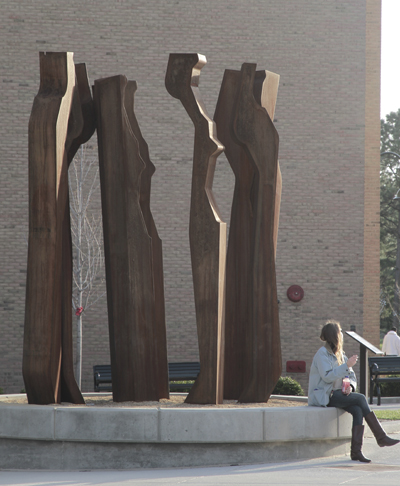University and artists dedicate sculpture walk
April 13, 2011
var so = new SWFObject(‘http://www.staterinteractive.com/player.swf’,’mpl’,’665′,’450′,’9′);
so.addParam(‘allowscriptaccess’,’always’);
so.addParam(‘allowfullscreen’,’true’);
so.addParam(‘flashvars’,’&file=SculptureWalk.flv&image=http://www.staterinteractive.com/photos/spring11/0131tv2.jpg&frontcolor=6666FF&lightcolor=EEEEEE&skin=http://www.staterinteractive.com/snel.swf&streamer=rtmp://flashmedia.kent.edu/fms-jmc/kentWired’);
so.write(‘tv2news’);
The artists who created four sculptures along the Esplanade talked with students, faculty and the community during the dedication of the Kent State Sculpture Walk at 10 a.m. Wednesday in the Kiva.
The four sculptures were part of the Ohio Percent for Art program and were chosen from a number of applicants by a 13-member committee. The program requires a certain percentage of state funds used for building or renovations be put towards getting and installing local artists’ work.
Three of the four sculptors, Giancarlo Calicchia, Susan Ewing and Jarrett Hawkins spoke and were presented an award. The fourth sculptor, Barry Gunderson, was unable to attend the event.
Following the ceremony, the group was invited to walk to each sculpture and to talk with the artists about their pieces.
“The Limits of Spoken Language: Congeries” by Jarrett Hawkins, a sculptor from Deer Park, is outside the Library in Risman Plaza.
His piece about the limits of language is made of 12-foot sheets of Corten Steel.
“For me, citing a piece at the University Library verges on poetic,” Hawkins said. “If the university is a place of ideas, the library is the gathering point of ideas past and present to be accessed at means.”
He said the longest part of the process of developing his piece was creating the smaller scale model out of foam and wire to present as a preliminary idea. It took a day for a crew to install the sculpture on campus.
“The Witnesses” featuring “Athleta” by Giancarlo Calicchia is on the hill by Kent Hall.
Calicchia is a Cleveland sculptor who excavated the granite rocks for the piece from his vineyard in Madison Township.
“When I first heard about the art program for Kent State, I was very excited, mostly because I felt my work belonged here,” Calicchia said.
He said he developed a love for hills from his childhood growing up in Italy and chose the spot for his sculpture because of the hill. He was able to use models to lay his sculpture out before putting the piece in place.
He said it is called “The Witnesses” because the stones witnessed their own creation and their coming into Ohio from all around the world. He said now he wants them to witness our existence and what we’ve done during our generation.
“These particular pieces were in the making for millions of years,” Calicchia said. “One day, I thought, ‘I’m an immigrant.’ We’re all immigrants, and so are these pieces, so maybe we are meant to meet; we were meant to do something together — not sure if they carved me or if I carved them.”
His carved granite stones are supposed to represent parts of humans who never stop growing, changing and transforming.
“Eye to Eye” by Barry Gunderson is located by Kent Hall.
Gunderson was unable to attend the dedication of the Sculpture Walk.
He is an art professor at Kenyon College. His piece is his take on the human mind and how it works. The sculpture is a tribute to the Department of Psychology.
The sculpture is supposed to show how people perceive each other and the idea of communicating their thoughts.
“Starsphere 2010” by Susan Ewing is by Franklin Hall.
Ewing is the associate dean of the School of Fine Arts at Miami University.
“I wanted in the worst way to do a piece for Franklin Hall,” Ewing said. “That to me may be my most important piece to date because it resonates on so many levels with me on the idea of freedom and the freedoms that we have through the first amendment.”
She said the piece is a tribute to the impact photojournalism and communications had in telling about May 4, 1970.
Her sculpture is made of three disks with stars meeting in the middle. Her idea originated from a bracelet she created in Prague. The entire first amendment is spot welded on the outside ban of the sculpture in reverse text.
“The star is an euphoria, transient, ephemeral quality of truth and light,” Ewing said. “I hope this piece captures the light of the star that comes through the centerpiece. The piece is such a vehicle for that communication.”
Contact Brooke Bower at [email protected].












